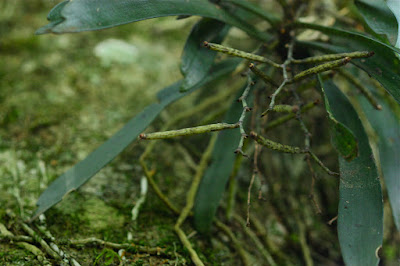Aerangis ugandensis is native to Uganda, Kenya, Rwanda, Burundi, and Congo-Kinshasa (Zaire, Democratic Republic of the Congo) in rather low-elevation evergreen forest, often near a river. They usually grow in deep shade on tree trunks among moss at 1500-2000 m.
Aerangis ugandensis also called as The Ugandan Aerangis, is a species of the genus Aerangis. This species was described by Victor Samuel Summerhayes in 1931.
IDENTIFY AERANGIS UGANDENSIS ORCHID PLANT
Aerangis ugandensis is native to Uganda, Kenya, Rwanda, Burundi, and Congo-Kinshasa (Zaire, Democratic Republic of the Congo) in rather low-elevation evergreen forest, often near a river. They usually grow in deep shade on tree trunks among moss at 1500-2000 m.
It is a monopodial, miniature sized, warm to cool growing epiphyte with short, up to 20 cm long stems, with 6 to 8, distichous, cuneate or cuneate-oblanceolate, unequally bilobed at the apex leaves with numerous parallel veins.
The Ugandan Aerangis blooms in the fall from 2 or more, 15 cm long, axillary, pendant, racemose inflorescence with 10 to 15 apical flowers opening first and the central flowers being the largest. The flowers are white, often tinged with green. Dorsal sepal erect, oblong-lanceolate apiculate or subacuminate; lateral sepals similar but often slightly reflexed. Petals reflexed, oblong- lanceolate, acute. Lip oblong, suddenly acute or cuspidate; spur straight, narrowly tubular. Column short, terete below, slightly dilated above; anther cap conical; rostellum straight, directed downwards towards the mouth of the spur; pollinia globose; stipes slightly widened in the upper half; viscidium round and flat, at right angles to the rostellum.
AERANGIS UGANDENSIS ORCHID PLANT CARE AND CULTURE
Cultural information should only be used as a guide, and should be to be adapted to suit you. Your physical location; where you grow your plants, how much time you have to devote to their care, and many other factors, will need to be taken into account. Only then can you decide on the cultural methods that best suit you and your plants.
Light:
Aerangis ugandensis needs a light level of 12000-20000 lux. This species grows well with indoor window sill or artificial light culture.
Temperature:
The summer days temperatures average is at 22-26°C, and nights temperatures average at 12°C, with a diurnal range of 11-13°C.
Humidity:
The averages humidity are 70-75% most of the year, dropping to near 65% for a short period in early spring. In late summer, values increase for a short period before falling to 55-60% for 3 months.
Substrate, growing media and repotting:
Aerangis ugandensis probably is more easily managed and the pendent flower spikes are more easily displayed when plants are mounted on slabs of tree-fern or rough bark. Mounted plants need high humidity, however, and during hot, dry weather they may need several waterings a day.
If it is difficult to keep mounted plants moist enough, they may be grown in a shallow pot or basket filled with a very open, fast-draining medium that has excellent drainage, is well aerated, and allows the medium to dry fairly rapidly after watering.
You can use coarse fir bark or shredded tree-fern fiber and add varying amounts of chunky perlite and/or chopped sphagnum moss to keep the medium open and retain some moisture in exceptionally dry areas. Including charcoal in the mix also holds the medium open and prevents souring in the pot.
The plants should be repotted immediately if the medium starts to break down or whenever the plant outgrows its container. Repotting should be done just as new roots start to grow. This enables the plant to become reestablished in the shortest possible time.
Watering:
The cultivated plants should be kept moist during periods corresponding to the wet seasons. They should be allowed to dry slightly between waterings during the dry seasons, but should never dry out completely or be left dry for extended periods. If the weather is hot, mounted plants should be drenched daily, or soaked (dunked) 3 times a week.
Fertilizer:
A balanced fertilizer, mixed at 1/4-1/2 recommended strength, should be applied weekly during periods of active growth. You can use a fertilizer with lower nitrogen and higher phosphate in autumn.
If pots are used, the medium should be leached every few weeks to prevent salt buildup, especially when fertilizer is being applied most heavily. Plants should first be watered normally to dissolve any accumulated salts. An hour or so later, the medium is flushed with water equal to about twice the volume of the pot. Year-round leaching is important in areas with heavily mineralized water.
Rest period:
In winter, the day temperature is average at 19-21°C, and nights temperature at average 12°C, with a diurnal range of 8-9°C. Rainfall is low during a 4-month period in winter and for 2 months in summer. However, high humidity in the stream-side habitat and nightly cooling results in some moisture being available from dew. In cultivation, these conditions may be simulated by early morning misting, with thorough waterings given every two weeks or so. Plants should be watched carefully for signs of stress while water is reduced, particularly in summer. Water should be increased if such signs appear.















COMMENTS